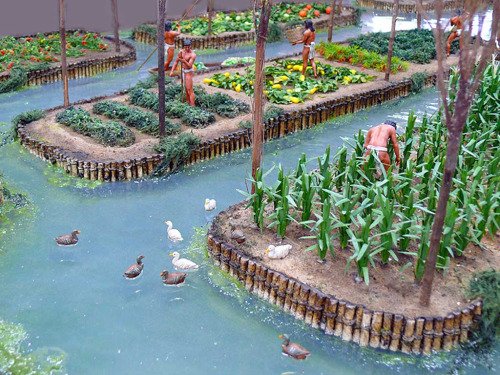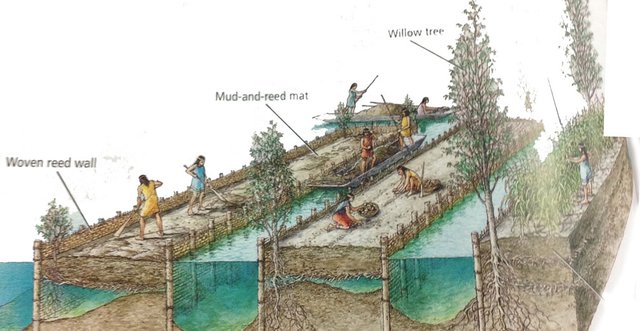Atlantis - Agriculture WOW!
Hello my Steemian friends today I will talk about Ancient North American Agriculture with regards to the AquaCulture or Hydroponics of the Aztec Civilization.

Years ago I did a vast amount of research on the Aztecs to write a novel about it but the cannibalism was so unacceptable for me to write about that I scrapped the idea. I did however find out about their method of faming and was able to perform several small recreations of it and like hydroponics. The Aztec AquaCulture was unbelievable in the amount of food it could produce for a city of twenty million inhabitants.

From the images of the Chinampas, we see that a very different system of agriculture was invented and used by the Aztecs and according to Wikipedia:
Chinampa
From Wikipedia, the free encyclopedia
Modern chinampas
The lake system within the Valley of Mexico at the time of the Spanish Conquest, showing distribution of the chinampas.
Chinampa (Nahuatl: chināmitl [tʃiˈnaːmitɬ]) is a type of Mesoamerican agriculture which used small, rectangularareas of fertile arable land to grow crops on the shallow lake beds in the Valley of Mexico.
Chinampas were created by the freshwater shoreline of the Northern portion of the central lake system of Mexico by the Nahua peoples, commonly called the Aztecs.[1][2][3] Sometimes erroneously referred to as "floating gardens", chinampas are artificial islands that were created by building up extensions of soil into bodies of water. Evidence from Nahuatl wills from late sixteenth-century Pueblo Culhuacán suggests chinampas were measured in matl (one matl=1.67 meters), often listed in groups of seven.[4][5] One scholar has calculated the size of chinampas using Codex Vergara as a source, finding that they usually measured roughly 30 m × 2.5 m (98.4 ft × 8.2 ft).[6] In Tenochtitlan, the chinampas ranged from 300 ft × 15 ft (91.4 m × 4.6 m)[6] to 300 ft × 30 ft (91.4 m × 9.1 m)[6][7] They were created by staking out the shallow lake bed and then fencing in the rectangle with wattle. The fenced-off area was then layered with mud, lake sediment, and decaying vegetation, eventually bringing it above the level of the lake. Often trees such as āhuexōtl [aːˈweːʃoːt͡ɬ] (Salixbonplandiana)[3] (a willow) and āhuēhuētl [aːˈweːweːt͡ɬ] (Taxodium mucronatum)[8] (a cypress) were planted at the corners to secure the chinampa. In some places, the long raised beds had ditches in between them, giving plants continuous access to water and making crops grown there independent of rainfall.[9] Chinampas were separated by channels wide enough for a canoe to pass.[citation needed] These raised, well-watered beds had very high crop yields with up to 7 harvests a year. Chinampas were commonly used in pre-colonial Mexico and Central America. There is evidence that the Nahua settlement of Culhuacan, on the south side of the Ixtapalapa peninsula that divided Lake Texcoco from Lake Xochimilco, constructed the first chinampas in C.E. 1100.[10]
Cited-https://en.wikipedia.org/wiki/Chinampa
The other method was to build barges out of reeds and fill the barges with dirt. These barges could be absolutely huge and contain whole orchards.
The floating islands encouraged fish populations and the fish helped fertilize the plants and control insects.
I have made several small models in my life in pools. I used styrofoam cooler lids with holes poked in the bottom to allow water in and for the roots to grow through. Cabbages, broccoli, lettuce, and more was grown using this method and the production was unbelievable.
I also used pots with the bases in the water about and inch that were setting on stones at the proper height. Vine plants like tomatoes grew eight feet high and produced far more than their normal ten pounds of tomatoes per plant.
I also put in fish to control algae and eat bugs. The aquaculture growing method was almost completely free of pests because many of the insects would alight upon the water spaces of the pool and they would drown or be eaten by the fish.
With the most advanced system of food production in the world so far ahead of its time and lost from most everywhere else, could this be a remnant of the lost civilization of Atlantis?
Image Sources:
Media.tumblr.com- 66.media.tumblr.com/6d9a5b4632426a67ee0f20bd3c713972/tumblr_o6ojioICgC1qarbuho1_500.jpg
Antkneebrown.blogspot.com- 4.bp.blogspot.com/-6jFfIR1WSQ8/VdPYNQNCXzI/AAAAAAAABtk/TwfzmxZr8XI/s1600/chinampas.jpg
[Images links to browse:] (https://images.search.yahoo.com/yhs/search;_ylt=AwrTccRPJgJZyLAAIx0PxQt.;_ylu=X3oDMTByNWU4cGh1BGNvbG8DZ3ExBHBvcwMxBHZ0aWQDBHNlYwNzYw--?p=Aztec+aquaculture&fr=yhs-iry-fullyhosted_003&hspart=iry&hsimp=yhs-fullyhosted_003)
Please feel free to comment and share your thoughts as we armchair archaeologists toss around the location of the lost continent of Atlantis
Related Articles
Atlantis Table of Contents
Please upvote and resteem. Thanks!
Thats an intersting article about acient agriculture. I'm not familiar with legends about Atlantis on this issue (can you suggest a reference about recent archaeological research on Atlantis?). In fact acient history is a great pool for ideas how to get back to a sustainable agriculture in our time. Another example is the biochar vision, that was also discovered through the observation of Amazonian dark earths from a vanished civilisation. Also permaculture is for me an old technique that we will have to catch up with again in order to preserve our planets resources.
There is no archaeological research on Atlantis because it was a myth my dear friend @pyroman - well there might be but you never know. The point of these Atlantis articles is to suggest that Plato's documentation was poetic and metaphorical. The suggestion is that Atlantis did not sink beneath the sea, something happened and we are no longer able to get to it.
I do know about the Amazonian agricultural methods but I wanted to add that at a latter time. Under the geoglyphs article, a lot of speculations as to how and why they were made occurred, by no means the final story.
One of the things I thought about, thanks to your comment is: called the Aztec, Incan, and Mayan civilizations by archaeologists - what if they labelled it wrong and it is all different periods of Atlantis Civilization growth?
Excellent post dear friend @ jeff-kubitz very interesting and instructive, ignored the Aztec information of the hydroponic planting, thank you very much for this magnificent material
Thank you for appreciating this post my dear friend @jlufer it is a mostly unknown fact and just restarted this system in Mexico in the last few years.
Waao
What an amazing jeff-kubitz! I just posted one on chinampas as well, and linked yours in it, as it is very well explained with lots of good details. Take a look if you like: https://steemit.com/gardening/@stortebeker/chinampas-traditional-farms-in-the-valley-of-mexico